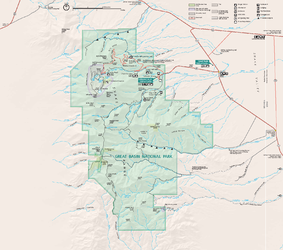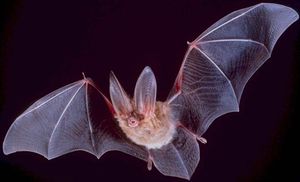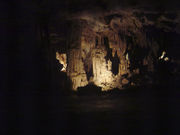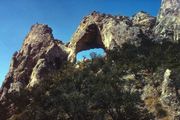Great Basin National Park
| Great Basin National Park | |
|---|---|
|
IUCN Category II (National Park)
|
|
 |
|
| Location | White Pine County, Nevada, USA |
| Nearest city | Ely, Baker, Border |
| Area | 77,180 acres (31,230 ha) |
| Established | October 27, 1986 |
| Visitors | 78,524 (in 2006) |
| Governing body | National Park Service |
Great Basin National Park is a United States National Park established in 1986, located in east-central Nevada near the Utah border. The park derives its name from the Great Basin, the dry and mountainous region between the Sierra Nevada and the Wasatch Mountains. Topographically, this area is known as the Basin and Range Province.[1] The park is located approximately 290 miles (470 km) north of Las Vegas and protects 77,000 acres (31,000 ha).[2]
The park is notable for its groves of ancient bristlecone pines, the oldest known non-clonal organisms; and for the Lehman Caves at the base of 13,063 ft (3,982 m) Wheeler Peak. The caves were originally designated as the Lehman Caves National Monument on January 24, 1922, and they were later incorporated into the national park. There are a number of developed campsites within the park, as well as excellent back country camping opportunities. Adjacent to Great Basin National Park lies the Highland Ridge Wilderness. These two protected areas provide contiguous wildlife habitat and contiguous protection to 227.8 square miles (590.0 km2) of eastern Nevada's basin lands.
Contents |
Climate
The park lies in an arid region and receives very little rainfall during most of the year. Most precipitation is winter snow or summer thunderstorms. All precipitation in this region evaporates, sinks underground or flows into lakes. No water reaches the ocean.[3]
Winters are cool and summers are mild to hot. Weather can change quickly, especially in the back country or on Wheeler Peak at high elevations. Lehman Caves maintains a fairly constant temperature of 50 °F (10 °C) with 90% humidity year round.[4]
Vegetation

There are 11 species of conifer trees and over 800 species of plants in Great Basin National Park and the neighboring valleys.[5] The area around the Visitor Center is dominated by plants such as sagebrush, saltbush, Single-leaf Pinyon, and Utah Juniper. Higher elevations are home to mountain meadows, White Fir, Quaking Aspen, Englemann Spruce, and large Ponderosa Pine. At treeline is an alpine area of low, delicate plants and rocky outcroppings.[6]
The oldest non-clonal organism ever discovered, a Great Basin Bristlecone Pine tree at least 5000 years old, grew at the treeline near Wheeler Peak in the National Park. It was cut down in 1964 by a graduate student and U.S. Forest Service personnel for research purposes. It was given the nickname Prometheus, after the mythological figure who stole fire from the gods and gave it to man.[7]
Wildlife
There are 73 species of mammals, 18 species of reptiles, 238 species of birds, 2 species of amphibians, and 8 species of fish in Great Basin National Park and the neighboring valleys.[5]
Mammals

An abundance of wildlife has taken advantage of the habitat zones in Great Basin National Park. Jackrabbits, pygmy rabbits, mountain cottontails, ground squirrels, chipmunks, and various mice live in the low-elevation sagebrush desert. pronghorn, coyotes, kit fox, and badgers are less common inhabitants.[6]
In the more rugged areas on the slopes of mountains and in the valley areas nearby, mountain lions, bobcats, marmots, rock squirrels, and mountain sheep can occasionally be seen. Other animals that can be found in the National Park include mule deer, spotted skunk, shrew, ringtail cat, and ermine.[6]
Fish
The Bonneville cutthroat trout is the only fish native to Great Basin National Park. It arrived in the mountain waters naturally and was eventually isolated by changing climatic conditions. Other trout species, such as Lahonton cutthroat, rainbow, brook and brown, were stocked in the lakes and streams of the South Snake Range until the Park's incorporation in 1986.[8]
Birds
Many species of birds can be found in Great Basin National Park, including hawk, sparrow, killdeer, wren, chickadee, eagle, magpie, and swallow.[9]
Amphibians
Only two species of amphibians have been positively identified in the southern Snake Range and adjacent portions of Snake and Spring valleys are the spadefoot toad (Scaphiopus hammondi) and the leopard frog (Rana pipiens).[10]
Lehman Caves

Several living creatures occupy the Lehman Caves. Bacteria are the most common. Crickets, spiders, pseudoscorpions, mites, and springtails may live their full life cycles in the cave. They are dependent on organic material packed in by other animals or washed in from the surface.[11]
Other animals use the cave but must leave to forage for food. These include chipmunks, mice, pack rats and several species of bat. There are only insectivorous bats in the Great Basin. At least ten species of bats have been found in the vicinity of Great Basin National Park, including the Townsend's big-eared bat.[11][12]
The caves were originally protected as a National Monument in 1922, which was combined with the national park in 1986.[13] [14]
The caves were most likely discovered in 1885 by Absalom Lehman.[14]
Lexington Arch

Lexington Arch is one of the largest limestone arches in the western U.S.[15] It can only be accessed from a dirt road south of the main part of the park, along Utah State Route 21. The turnoff has good signage, just south of Pruess Lake. After a 12 mile dirt road, a 1.7 mile hike (820 feet elevation gain) provides access to the arch.
Trails
Great Basin is best explored by hiking. The park has 12 trails ranging from 0.3 to 13.1 miles (0.48 to 21.1 km). Trails range from short nature trails at 6,825 feet (2,080 m) (Mountain View Nature Trail), to the Wheeler summit trail starting at 10,160 feet (3,097 m). The Wheeler Summit trail is quite strenuous, and the altitude presents significant hazards for unprepared or inexperienced hikers. Backcountry routes are occasionally maintained throughout the more remote southern portion of the park. A number of these trailheads are accessible by the dirt road that terminates at the primitive Shoshone campground.
Visitor Center
The Great Basin Visitor Center, located on Nevada State Route 487 in the town of Baker, is open daily 8:00 to 4:30 Pacific time, with extended hours in the summer. The Lehman Caves Visitor Center, located on Nevada State Route 488, is open daily 8:00 to 4:30 Pacific Time, with extended hours in the summer. It is 5.5 miles (8.9 km) from Baker, Nevada, 0.5 miles (0.80 km) inside the park boundary. Both centers feature exhibits about the park's geology, natural and cultural history, as well as theaters with orientation films. The centers are closed Thanksgiving Day, Christmas Day, and New Years Day. Great Basin National Park has between 79,000 and 89,000 visitors in a normal year, and operates on a budget of approximately $1.9 million.
Gallery
 Stella Lake |
 Great Basin National Park |
Mountain stream flowing from Wheeler Peak |
Wheeler Peak at Sunset |
See also
- Lehman Orchard and Aqueduct
- Rhodes Cabin
| NPS.gov photos | |
| Johnson Lake Mine | |
References
- ↑ "Geology of the South Snake Range". National-park.com Main page. http://www.great.basin.national-park.com/air.htm#geol. Retrieved 2010-06-01.
- ↑ http://www.npca.org/darkhorizons/pdf/GRBA.pdf Great Basin National Park: Air Quality at Risk National Parks Conservation Association
- ↑ "The Great Basin". Great Basin National Park. National Park Service. http://www.nps.gov/grba/planyourvisit/the-great-basin.htm. Retrieved 2008-11-21.
- ↑ "Welcome to the Great Basin!". Great Basin National Park. National Park Service. http://www.nps.gov/archive/grba/home.htm. Retrieved 2008-11-21.
- ↑ 5.0 5.1 "Things To Know Before You Come". Great Basin National Park. National Park Service. http://www.nps.gov/grba/planyourvisit/things2know.htm. Retrieved 2008-11-21.
- ↑ 6.0 6.1 6.2 "Mammals". Great Basin National Park. National Park Service. http://www.nps.gov/archive/grba/mammals.htm. Retrieved 2008-11-21.
- ↑ Cohen, Michael. "Oldest Living Tree Tells All". Terrain.org. http://www.terrain.org/essays/14/cohen.htm. Retrieved 2008-11-21.
- ↑ "Fish in the Desert?". Great Basin National Park. National Park Service. http://www.nps.gov/archive/grba/Plan/Fish/fish.htm. Retrieved 2008-11-21.
- ↑ "Birds". Great Basin National Park. National Park Service. http://www.nps.gov/archive/grba/birds.htm. Retrieved 2008-11-21.
- ↑ "Amphibans". Great Basin National Park. National Park Service. http://www.nps.gov/archive/grba/amphibianlist.htm. Retrieved 2008-11-21.
- ↑ 11.0 11.1 "Ecology of Lehman Caves". Great Basin National Park. National Park Service. http://www.nps.gov/archive/grba/caveecology.htm. Retrieved 2008-11-21.
- ↑ "Bats". Great Basin National Park. National Park Service. http://www.nps.gov/archive/grba/bats.htm. Retrieved 2008-11-21.
- ↑ "Lehman Caves National Monument". National Park Service. http://www.nps.gov/grba/historyculture/lehman-caves-national-monument.htm. Retrieved 31 January 2010.
- ↑ 14.0 14.1 "Lehman Caves Discovery". NPS. http://www.nps.gov/grba/historyculture/lehman-caves-discovery.htm. Retrieved 31 January 2010.
- ↑ http://www.nps.gov/grba/planyourvisit/lexington-arch.htm
|
||||||||||||||||||||||||||||||||||||||
|
|||||||||||
